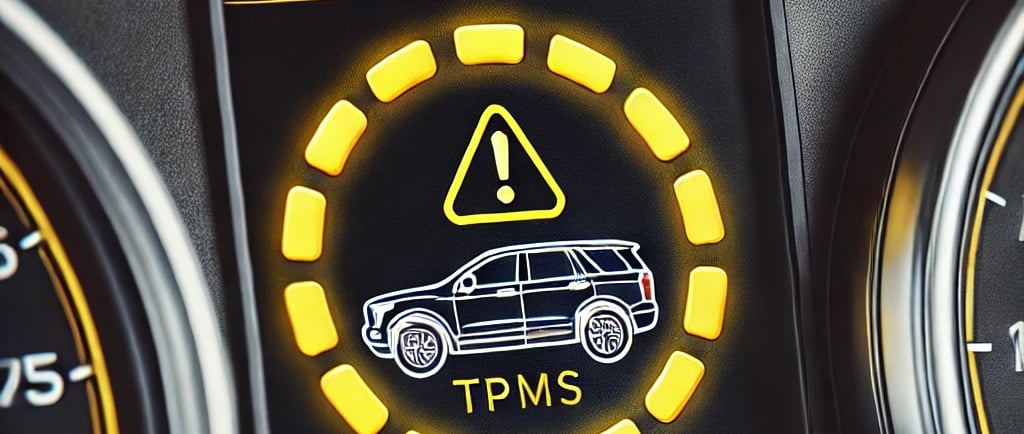Understanding TPMS: How It Works and Why You Need It
Blog | Discover the crucial role of Tire Pressure Monitoring Systems (TPMS) in vehicle safety and efficiency. Learn about the differences between Direct and Indirect TPMS, the benefits of maintaining proper tire pressure, and the top TPMS manufacturers. Enhance your vehicle's performance, safety, and fuel efficiency with regular TPMS maintenanceBlog post description.
TPMS
George D.
7/4/20243 min read


Understanding TPMS: Types and Benefits
Proper tire maintenance is crucial for vehicle safety and performance. One key component in this process is the Tire Pressure Monitoring System (TPMS). Let's dive into the types of TPMS and their benefits.
How TPMS Works
TPMS uses sensors mounted inside the tire or on the valve stem. These sensors continuously monitor the air pressure within the tire and transmit this information to the vehicle’s onboard computer. When the pressure in any tire falls below the recommended level, the system triggers a warning light on the dashboard to alert the driver. This real-time monitoring helps maintain optimal tire pressure, ensuring better handling, fuel efficiency, and reduced tire wear.
The Tire Pressure Monitoring System (TPMS) was developed to enhance road safety and improve fuel efficiency. Initially, TPMS was utilized in racing cars where precise tire pressure control was crucial. However, the first commercial implementation of this technology occurred in 1986 when Porsche equipped its model 959 with TPMS. This system was designed to alert drivers to low tire pressure, helping to prevent accidents and increase road safety.
The widespread adoption of TPMS began after 2000, particularly in the United States. This shift was driven by the TREAD Act (Transportation Recall Enhancement, Accountability, and Documentation) passed in 2000. The act was a response to numerous rollover accidents caused by tire failures, which resulted in many injuries and fatalities. The TREAD Act mandated that all new vehicles sold in the United States from 2007 onwards be equipped with TPMS.
Types of TPMS
Direct TPMS
Direct TPMS uses sensors placed inside each tire to measure pressure directly.
How it works: Sensors send real-time data to the vehicle's onboard computer via radio frequency (RF) signals.
Pros: High accuracy, and real-time monitoring.
Cons: Higher initial cost, sensors may need replacement with new tires.
Indirect TPMS
Indirect TPMS estimates tire pressure by monitoring wheel speed using the ABS system.
How it works: Measures differences in wheel speed to infer pressure changes.
Pros: Lower cost, integrates with existing systems.
Cons: Less accurate, may not detect slow leaks or gradual pressure loss.
Benefits of TPMS
1. Enhanced Safety TPMS alerts drivers when tire pressure is low, reducing the risk of blowouts and accidents. According to the National Highway Traffic Safety Administration (NHTSA), approximately 2% of traffic accidents are related to vehicle maintenance issues, including poor wheel alignment.
2. Improved Fuel Efficiency Maintaining proper tire pressure reduces rolling resistance, which can improve fuel efficiency by up to 10%. Properly inflated tires also wear evenly, extending their lifespan and saving money on replacements.
3. Extended Tire Life Consistent tire pressure prevents uneven wear and tear. Properly aligned and inflated tires can last up to 20% longer, providing better performance and reducing the frequency of replacements.
Major TPMS Manufacturers
Several key companies dominate the TPMS market, providing reliable and innovative solutions for vehicle safety:
Schrader Electronics: A pioneer in TPMS technology, known for its high-quality direct TPMS sensors. Schrader is considered one of the largest suppliers of TPMS sensors globally.
Continental: Offers both direct and indirect TPMS solutions, recognized for their reliability and accuracy.
Huf Hülsbeck & Fürst: Specializes in innovative TPMS solutions, providing systems for various vehicle manufacturers.
Pacific Industrial Co. Ltd.: Supplies TPMS sensors and systems globally, known for their durability and precision.
Denso: A leading supplier of TPMS sensors, providing high-quality products to ensure optimal tire performance and safety.
How to Maintain Your TPMS
Regular maintenance of your TPMS is essential for optimal performance. Here are some tips:
Regular Checks: Even with TPMS, manually check your tire pressure monthly.
Sensor Maintenance: Replace sensors as recommended by the manufacturer, typically every 5-10 years.
Professional Inspections: Have your TPMS checked during routine vehicle maintenance to ensure it's functioning correctly.
Conclusion
The TPMS is a vital tool for maintaining vehicle safety, improving fuel efficiency, and extending tire life. Regular maintenance and understanding the system's functionality can help you get the most out of your TPMS. Keeping an eye on your tire pressure not only keeps you safe but also saves money in the long run.
George D.
George's Alignment & Brake Service
Contacts:
Tel: +1 818 855 6545
Operation hours:
Mon-Fri: 10am - 5pm Sat: 9am - 5 pm
Service areas:
Calabasas Canoga Park Chatsworth Encino Granada Hills Hidden Hills Lake Balboa Northridge
Porter Ranch Reseda Sherwood Forest Tarzana Van Nuys West Hills Winnetka Woodland Hills
